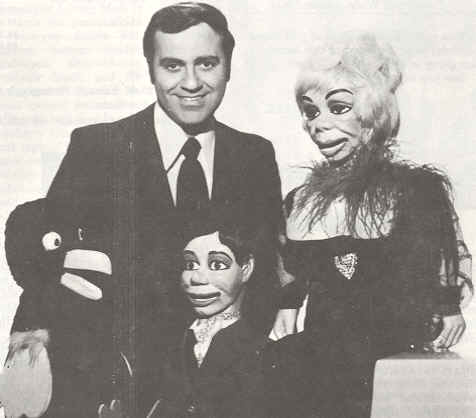Past Conventions
2007
2006
2005
2004
2003
2002
Archives
Tips and Techniques
Blasts from the Past
Anecdotes
|
|
| xx |
Mary Ann Taylor's 10 Top Ten Tips for Soft Puppet Care Manipulation: The Illusion of Life by Pete Michaels The Secret of Ventriloquism by Jay Johnson Vent ConVENTion 101: How to Have a Great Time at a Vent Haven ConVENTion by Mark Wade Mic & Sound System Technique by Jeff Dunham Dealing with Media: Radio by Gary Owen The Dummy Sings: Using Music in Your Act by Pete Michaels The Art of Ad-Libbing by Jeff Dunham
Mary Ann Taylor's Top Ten Tips for Soft Puppet Care by Annie Roberts 10.
Keep out of the sun. Dyed cloth will fade. 9.
If your figure is on a stand when not performing, cover the top of
the dowel rod with a foam ball or tennis ball to protect the head. 8.
Do not store in plastic bags. Enclosing
fumes breaks down the foam. 7.
Do not use athletic bags. The
seams rub against the figures causing slow damage.
Use a bag with material like cotton that breathes. 6.
Use pastel pencils to touch up wrinkles around the eyes. 5. Use a hair dryer to
fluff feathers or blow eyelashes if they get flattened by a bag. 4. If your hand sweats
a lot, use a cotton glove to soak up the sweat and protect the inside of
the puppet. 3.
Don�t leave your figure in the car.
Heat over time will deteriorate.
2. Scotchguard your
figure every six months. Be
sure to cover the eyes with masking tape.
Scotchguard will destroy the eyes unless you cover them.
Spray from at least 12 inches away 1. When traveling and storing, do not compress or put pressure on foam.
Mary
Ann Taylor is the premier soft-sculpture figure maker. She has been
making custom figures for 20 years. Her interest in this specialty
began when her husband took an interest in ventriloquism and came to the
Vent Haven Convention. Seeing the work of Verna Finly, Taylor knew
she could do soft-figure making too. She has been creating custom
figures ever since. Every year she creates and donates a figure for
the Vent Haven Raffle where all proceeds go to Vent Haven Museum. Prior to this career, Mary Ann Taylor worked as
an art teacher, a courtroom artist, and an illustrator.
By Pete Michaels Aside from lip control, manipulation is
probably the most important aspect of Ventriloquism. I can remember as a child, watching
Jimmy Nelson, Paul Winchell and Edgar Bergen on TV and the thing that
fascinated me more than their lip control was how they made the puppet
come alive!
And, Charlie also had a flat bottom
neck. Not the �ball & socket� type we are used to. Yet, Look at Mortimer Snerd in the hands of Then, there�s Danny O�Day. Fresh,
brash. Always looking at Jimmy or Farfel before turning his head and
going, �Sheesh!� Again, we can see the life-like movements that made
Danny seem like a smart-aleck kid. And Farfel; who would just sit there and
cock his head to one side while cutting Danny to pieces. Not a great deal
of manipulation here, BUT note how Jimmy moves Farfel�s head and mouth.
He seems like a real dog. And if a real dog COULD turn his head and talk,
that would be what he would surely look and sound like. N Another one was when he�d have Jerry
lean in, face-to-face and say. �Kiss me.� I stress� Also, try to get into the habit of
having the puppet actually �look� at someone in the audience. Practice
by conversing with someone, and when the person is speaking to the figure,
have the figure �respond� both verbally When we talk to someone, we don�t just
stare at them, we interact. Nod our heads in agreement or shake in
disagreement. Do the same with the figure. On the subject of winkers, it looks a
little �robotic� to have the figure blink his eyes every few seconds
like people do. (It spooks some audience members too.) Rather, have him
blink or close his eyes for EFFECT. As in when Jerry Mahoney said, �Get
outta here!� Using one winker to flirt with a girl in the audience is
cute and is also something your figure may do, if that is in his
character. If your figure has all the �bells
& whistles,� remember you Keep the movements simple and with
purpose. If you have an arm control rod or dowel
installed, use it to mimic how someone would hold or move their arm and
hand. Remember, less is more. Keep it subtle. When manipulating the head, think of
Charlie, Mortimer, Danny and Jerry. Each puppet had their own unique way
of turning, tilting, and moving their head. If you watch clips of Woody D. and Mr.
Johnson, you will see two distinct styles of manipulation. Woody tends to
be more energetic, as a kid WOULD be, and Jr. Johnson moves slower, as an
old man would
THAT is Manipulation! The Illusion Of
Life! |


 Manipulation:
The Illusion Of Life
Manipulation:
The Illusion Of Life Bergen,
for example, did not rely on the many controls that now seem standard on a
vent figure. Charlie had a moving mouth. Period. (At least the Charlies
we�re accustomed to seeing in most of
Bergen,
for example, did not rely on the many controls that now seem standard on a
vent figure. Charlie had a moving mouth. Period. (At least the Charlies
we�re accustomed to seeing in most of  ow,
let�s look at Jerry Mahoney. Jerry had not only moving eyes, but winkers
as well. Winchell was expert at manipulating Jerry with both slow and
quick movements. One of my favorite Mahoney-isms is when Paul would have
Jerry pull his head away and say, �Get outta here.�
ow,
let�s look at Jerry Mahoney. Jerry had not only moving eyes, but winkers
as well. Winchell was expert at manipulating Jerry with both slow and
quick movements. One of my favorite Mahoney-isms is when Paul would have
Jerry pull his head away and say, �Get outta here.� One of the greatest figure manipulators was the late Johnny Main. He
could make ANY figure come to life in his hands. If you looked closely,
you would swear the figure was BREATHING!
One of the greatest figure manipulators was the late Johnny Main. He
could make ANY figure come to life in his hands. If you looked closely,
you would swear the figure was BREATHING!